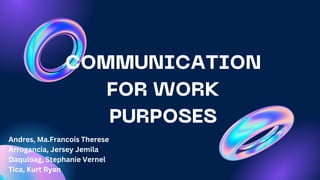
Communication For Work Purposes Workplace Communication
- 1. Andres, Ma.Francois Therese Arrogancia, Jersey Jemila Daquioag, Stephanie Vernel Tica, Kurt Ryan
- 3. -is the process of exchanging information and ideas, both verbally and non-verbally between one person or group and another person or group witihin an organization. It includes e-mails, videoconferencing, text messages, notes, calls, etc.
- 4. messages distributed by electronic means from one computer user to one or more recipients via a network. E-MAIL VIDEO CONFERENCING a technology that allow users in different locations to hold face-to-face meetings without having to move to a single location together.
- 5. an electronic communication sent and received by mobile phone. TEXT MESSAGES NOTES CALLS a short informal letter or written messages. an instance of speaking on the phones or attempting to contact someone by phone.
- 7. a.) Am I writing to create a record, to request/ provide information, or to persuade? b.) What am I trying to say? •
- 8. a.) Who will read what I have written? b.) What are their job titles and/or areas of responsibility? c.)What do they already know about the specific situation? d.) Why do they need this information? e.) What do I want them to do as a result of receiving it? f.) What factors might inffluence their response?
- 9. A.) UPWARD COMMUNICATION -from your position to an audience above you in the job hierarchy. e.g. A response to a letter from your manager. A.) BLATERAL COMMUNICATION -between you and an audience within your level of hierarchy. e.g. A phone call to/from a co-worker you are collaborating with.
- 10. A.) DOWNWARD COMMUNICATION -from your position to an audience below you in the job hierarchy. e.g. An oral reminder to a trainee. A.) OUTWARD COMMUNICATION -between you and a company that you do business with or an audience outside your workplace. e.g. A letter of inquiry addressed to a supplier regarding a delivery to your office.
- 11. -it will set how your target audience will accept what you are trying to say. You do not have to sound tough, demanding, or condescending in your discourse especially in sensitive subjects or issues.
- 12. • SUPPRESSION OF INFORMATION. • FALSIFICATION OR FABRICATION. • OVERSTATEMENT OF UNDERSTATEMENT. • SELECTIVE MISQUOTING. • SUBJECTIVE WORDING. • CONFLICT OF INTEREST. • WITHHOLDING INFORMATION. • PLAGIARISM.